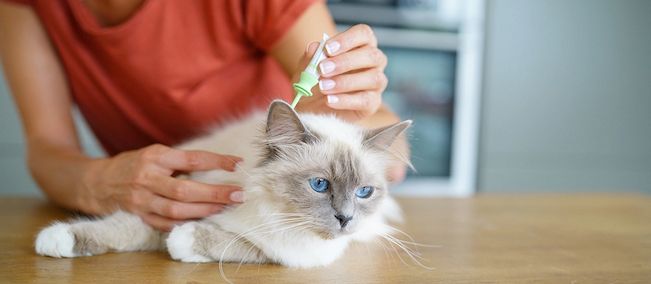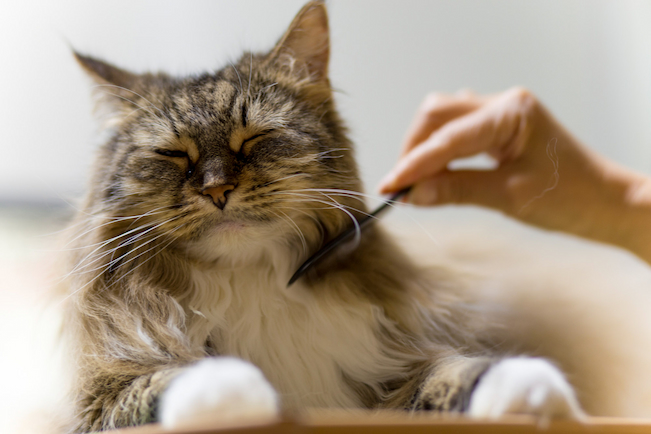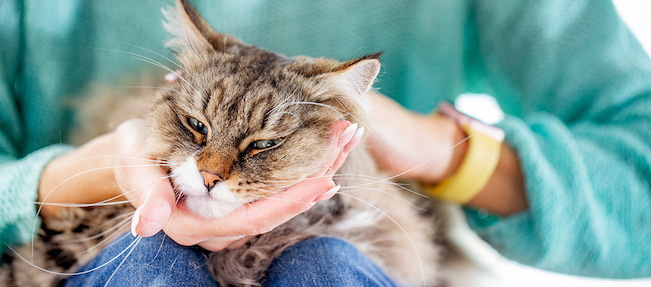Flea and tick infestations are the two of the most common problems affecting all pets, and these can be pretty annoying for pet owners. That makes flea and tick control essential to your cat’s care routine. How can you know if your cat has fleas and ticks? How important is flea and tick treatment for cats? And how can you choose the best cat flea treatment?
How to Detect If Your Cat Has Fleas?
Fleas are tiny insects, approximately 2-4 mm in length. They’re dark brown and visible to the naked eye. They can’t fly but can jump from one place to another. Ticks are bigger: adult ones can be as big as an apple seed. They usually stay latched onto the skin of the cat’s body. The first signs of your cat having fleas or ticks are restlessness, chewing, scratching or licking themselves more than usual.

If you notice that your cat behaves unusually, check their skin and coat for signs of parasites and flea dirt. Flea dirt is flea faeces that look like regular dirt. If you aren’t sure what is it, wipe it with a paper towel and add some water. If it’s a speck of flea dirt, it’ll turn into a brown colour with a reddish hue as it contains an excreted cat blood.
Why Is Flea and Tick Treatment Important for Cats?
Fleas and ticks are ectoparasites, meaning they’re parasites that live on the outside of the host animal. Both of them suck your animal’s blood; they must be attached to a host so they can draw blood to survive. The flea bite itself isn’t as big enough to cause a problem; their saliva is what causes serious health issues, such as severe allergies, dermatitis, anemia and infection.
On the other side, the tick bite can be more dangerous, causing infection and abscesses. Both fleas and ticks can transmit various diseases to your cats, such as Lyme disease, anaplasmosis and tapeworms. Although cats aren’t as susceptible to these diseases as dogs are, there’s still a risk of getting them. And some of them can even transmit to humans. That’s why it’s vital to include an effective flea and tick treatment for cats into your regular cat care routine!
What Are Cat Flea and Tick Treatments?
Anti-parasite products come in a few forms: pesticides, repellents and growth inhibitors. Each of them has a different purpose and helps fight pests at different life stages.

When choosing a flea and tick treatment, you must first understand what parasites are you dealing with. Some products are a treatment for cat fleas only, while others are combination products that contain multiple ingredients to kill different parasites. They typically provide prevention from both fleas and ticks, and sometimes they may also protect from heartworm, mites and intestinal parasites. How wide the spectrum of parasite control will depend on the specific product’s active ingredients.
How to Choose the Best Flea and Tick Treatment for Your Cat?
As there is a wide range of great flea and tick products available, picking the best one for your cat can be confusing. There are several factors, though, that can make it easier and less overwhelming for you.
Species
First and most important, ensure that the treatment you choose is for cats only. Cats aren’t small dogs, meaning you can’t use dog products in them. Doing so can cause some severe and often fatal reactions. For example, insecticides called permethrins are toxic to cats and can cause tremors, seizures and death. Always check the label first, even if you’re getting a prescribed treatment.

Application Method
The most common flea and tick treatments usually come in 2 forms: chewable tablets administered orally and liquid applied topically between the shoulder blades or down the neck.
Topical Products
Topical cat flea treatments can be very effective, especially spot-on treatments. They’re mostly combination products that combat a variety of parasites very successfully. Yet, there are some things to be careful about:
- If you have small children or other animals, make sure to isolate your cat when you apply the product as they can touch or lick it before it dries. That not only will make it ineffective, but it can also be harmful to your kids and smaller animals.
- If you bathe your cat more frequently, the products may wash off before it is time for reapplication. In this case, you may have to apply it more often.
- Consider your cat’s skin and coat: not every product is suitable for different skin and fur types.
Oral Products
If you decide on a tablet, you must know that most treatments require your cat to eat the entire tablet. You must carefully watch to make sure they eat the whole dose. This is especially important if your cat doesn’t like the taste of the pill. Also, ensure the quality of your cat’s nutrition on such days, so the pill won’t upset their stomach and make it easier to absorb.
Access to Outdoors

As outdoor cats have access to areas with a high tick and flea risk, they must receive treatment on time. However, indoor cats are also at risk, especially flea bites, as fleas can enter our homes through windows and doors, other outdoor pets, and humans.
Important Notes
Before starting any treatment on your cat, it’s always recommended to talk to your veterinarian, especially if your cat has some health issues. Reading labels is critical! Always check:
- If the product is the correct species;
- If the product is the right age for your animal;
- If the product is within the proper weight range for your pet;
- If it’s administered correctly;
- If the application method works with your bathing schedule;
- If you understand safety directions;
- If you have your vet’s number in case of an adverse reaction.
























